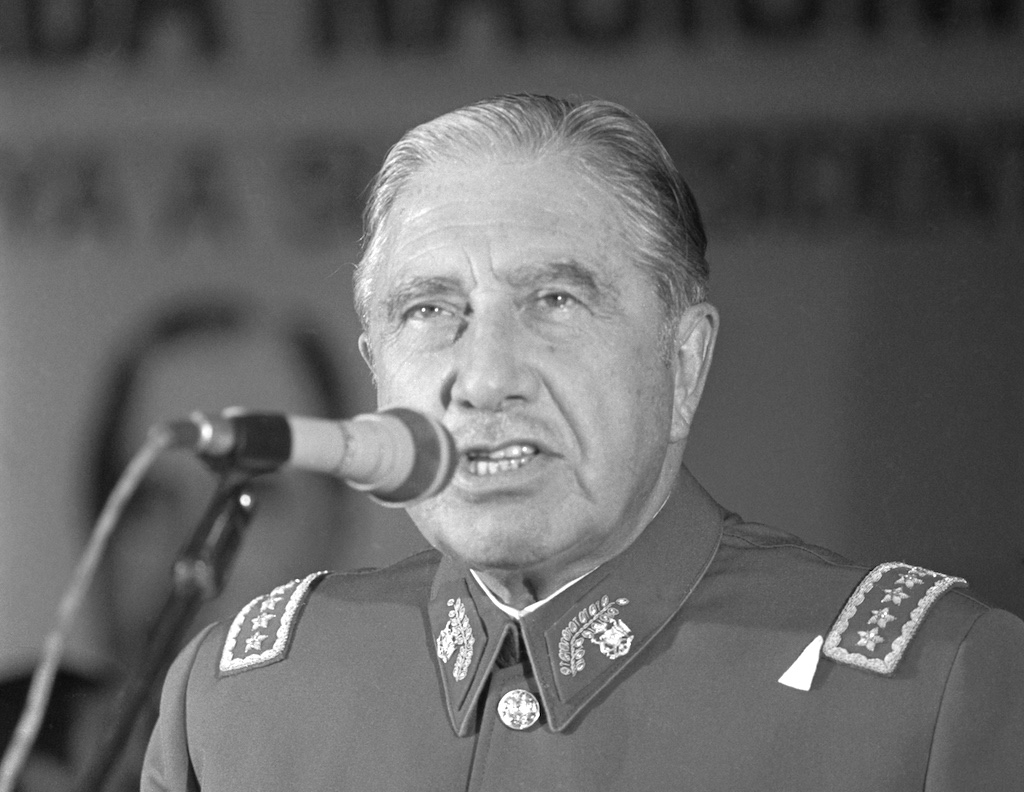Liberal Capitalism’s Long Authoritarian Streak
There is no simple opposition to be drawn between the liberal market order of the early 1800s and the supposedly more violent neoliberal state of the late 20th and early 21st centuries. Coercive projects and authoritarian visions run throughout both.

Chilean president General Augusto Pinochet addresses supporters in Santiago, May 1984. (Bettmann / Contributor / Getty Images)
We’re coming up, in two years, on the fiftieth anniversary of the publication of Albert Hirschman’s The Passions and the Interests: Political Arguments for Capitalism before Its Triumph. Some of you may know of Hirschman as one of the main characters in that not-so-good, pulpy Netflix series Transatlantic, which depicts the efforts of Hirschman and others to rescue European Jewish intellectuals from the Nazis in France. If you’re a political scientist or sociologist, you may know of Hirschman for his book Exit, Voice, and Loyalty. If you’re a theorist, you may know his Rhetoric of Reaction. If you’re an economist or a Latin Americanist, you might know of his work in development economics.
But, for me, Hirschman will always be the author of The Passions and the Interests. Its main thesis is that early-modern writers, from Machiavelli to David Hume, saw in the idea of interests — initially understood as a reasoned form of passion, later as a strictly economic pursuit of money and material well-being — as a counter to dangerous forms of political passion: glory, heroism, virtue, excessive civic-mindedness. It’s a wonderful little book, which in many ways has inspired some of the counterarguments that I am making in my book King Capital.
But there’s a little-noticed element in Hirschman’s book, which I only just stumbled upon in a recent rereading. Given when the book was written, in 1977, and given Hirschman’s extensive involvement in Latin American politics and economics and his many efforts to save Latin American Marxists and leftists who were being threatened by right-wing goons and governments in the 1970s, that subplot seems worth mentioning.
While the overall thrust of the book is about the pacifying and productively anti-political dimensions of market activity, Hirschman mentions, briefly, that both the Physiocrats and Adam Ferguson had a darker intuition about the uptick of market societies and commercial pursuits. From a supportive position, the Physiocrats argued that the “natural economy” was such a delicate instrument of infinite complexity that the best thing to do would be to leave it alone. Hence, laissez-faire: no fussing, no futzing.
But the Physiocrats were aware of political actors, elites, and commoners, who might be inclined to fuss and futz, so they sought to create a despotic government that would prevent anyone from tinkering with or touching the economy. A free-market economy, in other words, untouched by government, required a despotic leader to enforce that freedom.
Where the Physiocrats feared the people’s bubbling political energy and empowered the despot to put a lid on it, Ferguson feared the opposite: that the people’s desires for tranquility and peace as the conditions for the pursuit of commercial wealth would lead them to accept, even want, a despotism.
“Liberty is never in greater danger than it is when we measure national felicity . . . by the mere tranquility which may attend on equitable administration,” which is supposed to provide “the least possible interruption to commerce and lucrative arts; such a state . . . is more akin to despotism than we are apt to imagine.” Alexis de Tocqueville would later make this argument famous in the second volume of Democracy in America.
Summarizing (but by no means endorsing) these two positions, Hirschman wrote, just four years after the coup in Chile and one year after the junta seized power in Argentina, “If it is true that the economy must be deferred to, then there is a case not only for constraining the imprudent actions of the prince but for repressing those of the people, for limiting participation, in short, for crushing anything that could be interpreted by some economist-king as a threat to the proper functioning of the ‘delicate watch.’”
In the last thirty years, it’s become conventional wisdom to argue that what distinguishes neoliberalism from the nineteenth-century liberal market state is that where the latter was genuinely inspired by laissez-faire principles to leave the market alone, the former, the neoliberal state, is much more interventionist (and violent) in constructing and creating the economy.
The neoliberal state is not anti-statist at all; it merely ups the coercive elements of the state (the police and the courts) and the nondemocratic elements of the state (constitution and supranational law) to create a market order that cannot be touched by the people. Interestingly, it took liberal and left critics some time to come to this position; initially, they had repeated the shibboleth that neoliberalism empowers the market and diminishes the state. Not true, left theorists of neoliberalism began to argue in the late 1990s.
Hirschman not only shows that the neoliberal order could be extremely authoritarian and coercive — again, in 1977, long before most American observers were on to this — but also that such a project had deep roots in earlier liberal economic thought. There is no simple or easy opposition to be drawn between the liberal market order of the early nineteenth century and the neoliberal state of the late twentieth and early twenty-first. Coercive projects and authoritarian visions run throughout both. That idea runs counter to the dominant story of Hirschman’s text but makes it all the richer and more worth reading fifty years later.